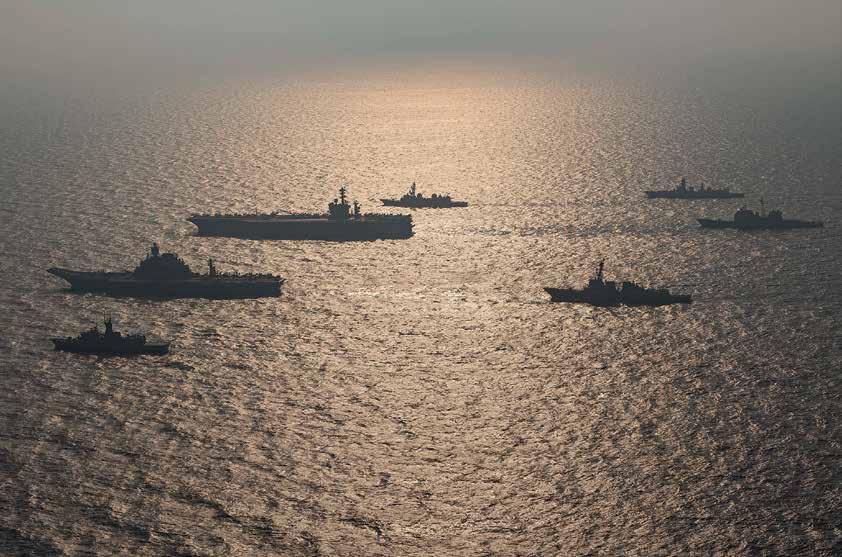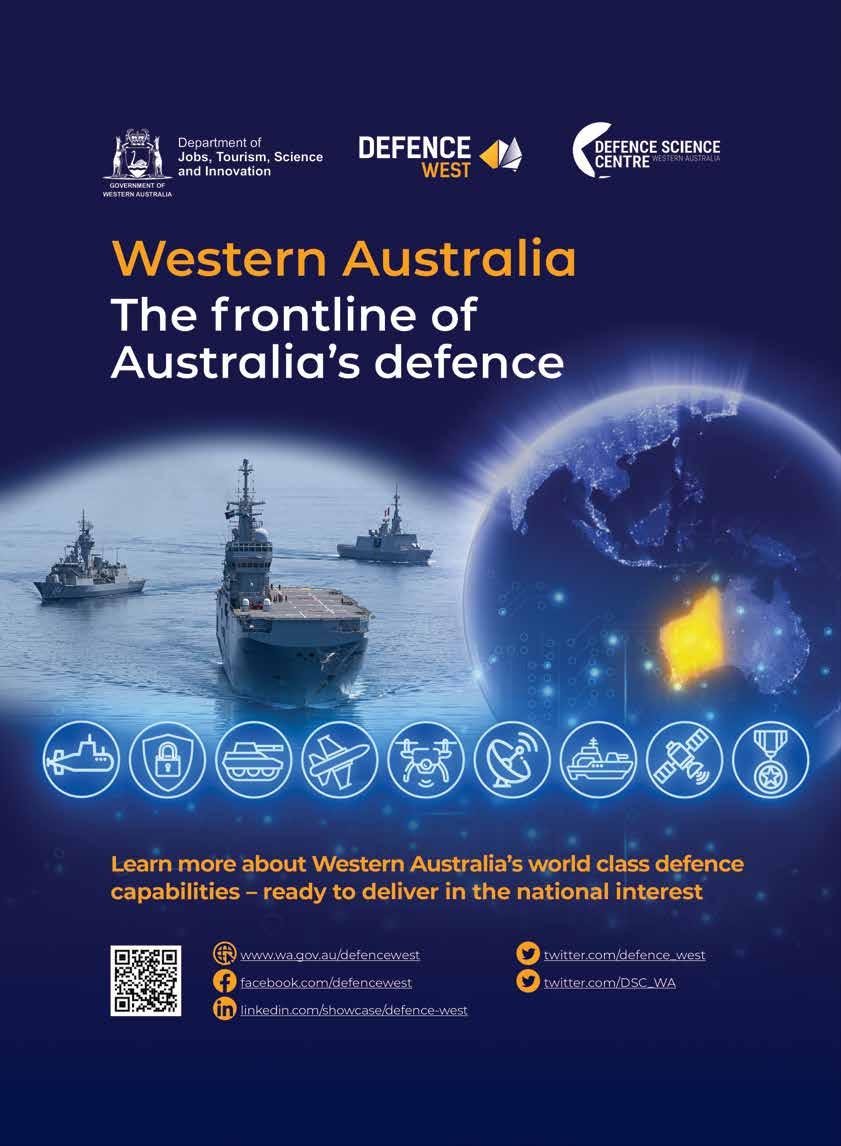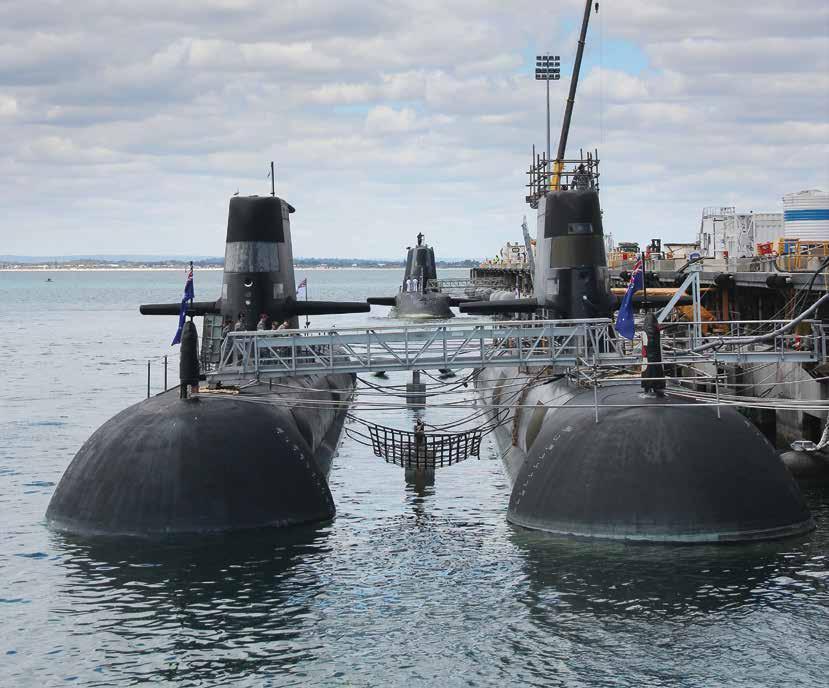
11 minute read
AUSTRALIA’S DANGEROUS AND UNCERTAIN DECADE AHEAD
By James Goldrick,
RADM (Rtd), Adjunct Professor at SDSC, Australian National University and at UNSW Canberra (ADFA).
We live in interesting times. Australia and its friends face the prospect of an increasingly powerful and authoritarian China bent on re-setting the global order and achieving dominance of its surrounding region.
FESTERING TENSIONS
Taiwan is increasingly a point of tension, and one that carries far greater risk of precipitating major conflict than China’s claims in the South China Sea. As the centenary anniversary of the Chinese Communist Party confirmed, China is determined to reincorporate Taiwan into China.
An armed conflict between China and Taiwan would be in no one’s interests, least of all China itself, but there remains the danger that both external and domestic pressures, including China’s internal narrative of ultra-nationalism, may see events spiral out of control. Furthermore, possession of the island has a new significance for China since it would give its naval forces unfettered access to the deep waters of the Pacific and thus to the world’s oceans.
This would create immediate problems not only for the United States but for Japan as well; a seadependent nation whose maritime approaches would be at much greater risk from an all-round threat. Japan’s increasingly robust attitude to the regional deployment of its own navy and recent public statements indicate that it is increasingly aware of its own interests in the continuing independence of Taiwan.
TESTING THE ALLIANCE
The implication for Australia is huge: if Japan should be open in its support for Taiwan, a crisis over the island may rapidly become a test not only of our alliance with the US, but of our nascent security relationship with Japan.
Ships from the Australian, United States, Japanese and Indian navies sail in formation in the Indian Ocean at the start of phase two of Exercise MALABAR 2020. © Department of Defence.

© WA DEFENCE REVIEW. Credit: Kaboom Toons.
The South China Sea will provide other tests. China continues to assert its power over the littoral states, which are subject to the continuing dilemma of balancing their own sovereign claims against the fear of Chinese reprisals. Australia cannot allow the South China Sea to become a closed sea, but our responses to China’s coercive behaviour and our presence in those waters and skies must be calibrated to the concerns of our friends in the region, as well as those of our major allies.
Such calibration applies in another region where Australia has key responsibilities - the South Pacific. The more sensitive our support for the Pacific islandcountries, the more effective will be our efforts to ensure that the region does not become a new focus for strategic competition. INDIAN OCEAN MILITARY BALANCE
The Indian Ocean is already the scene of such strategic competition, although this is not in itself a trigger for conflict. China has legitimate interests and key vulnerabilities, notably its dependence on oil via the Strait of Hormuz and the hundreds of thousands of Chinese nationals in Africa and other parts of the Indian Ocean littoral.
China’s Belt and Road initiative has encountered several obstacles, but China is bent on exploiting Africa’s natural resources and, quite probably, its demographic boom as a source of cheap labour in the years ahead. Indeed, the key challenge for Australia may be in ensuring that our leading position in iron ore and other resources is not threatened by the Chinese development and exploitation of of African mines.
For India in particular – and, it should be observed, for several members of the European Union – there will be increasing challenges by China to their customary influence around the Indian Ocean littoral. India itself will have to manage not only its contested land border with China, but the latter’s influence on Pakistan and in Afghanistan and other central Asian states. Australia will be a secondary player in this new ‘great game’ but cannot be oblivious to its outcome. Most importantly, Australia needs to work with India to share the burden of balancing China’s maritime presence in the region.
What Australia will see, as the Chinese navy learns to use its new power projection capabilities, will be an increasingly powerful Chinese naval presence to its north west and west, at levels even greater than that of the anti-piracy and flag showing deployments of the last decade and a half. This may not happen for a year or two, since the Peoples Liberation Army Navy seems to be adopting a cautious approach, learning by doing with

An armed conflict between China and Taiwan would be in no one’s interests, least of all China itself, but there remains the danger that both external and domestic pressures, including China’s internal narrative of ultra-nationalism, may see events spiral out of control. Furthermore, possession of the island has a new significance for China since it would give its naval forces unfettered access to the deep waters of the Pacific and thus to the world’s oceans.
its aircraft carriers but keeping them close to home.
Nevertheless, Chinese carrier battle and amphibious ready groups are likely to be a regular, if not semi-permanent presence in the Indian Ocean well before the end of the decade. They will be an important complement to China’s efforts to increase its influence around the Indian Ocean’s littoral. And they need to be matched, when appropriate, by an Australian maritime presence powerful and persistent enough to demonstrate our capacity for action.
Efforts to exert Australian influence must extend further. Our presence should also include measures which support maritime security in the wider sense, such as through capacity building in the smaller littoral states. This could include creating an Indian Ocean
The upgraded facilities at HMAS Stirling and Fleet Base West in Western Australia will gather renewed importance as the AUKUS trilateral security partnership rises in prominence. © Department of Defence.

Patrol Vessel Program and extending to the region the associated support and training programs which have underpinned the long-standing Pacific Patrol Boat Program and its successor Pacific Maritime Security Program. Another concept that has recently been proposed is the establishment of a Perth-based Indian Ocean Maritime Academy. As with the Pacific schemes, in which New Zealand plays a role, this does not have to be a purely national effort and could provide another avenue for cooperation with India. QUAD NOT ENOUGH
In managing these and other responses, Australia must be both independent and collaborative in asserting its national interests. The alliance with the US remains the keystone of our security arrangements. This has been strongly reaffirmed by AUKUS, a major new agreement which has, interestingly, also demonstrated Britain’s renewed intent to be a contributor to Indo-Pacific security. Nevertheless, success in handling the rise of China will also depend upon our ability to develop new links with Japan and India, and with countries like Indonesia - a nation too often given lesser priority in Australia’s external relationships - as well as the other members of ASEAN.
In other words, AUKUS and the Quadrilateral Security Dialogue (the ‘Quad’), are not enough. They are extremely important - if not critical - but even the Quad must be much more than a military coalition. China’s economic bullying of Australia has provided a stark, perhaps timely, demonstration that

Efforts to exert Australian influence must extend further. Our presence should also include measures which support maritime security in the wider sense, such as through capacity building in the smaller littoral states. This could include creating an Indian Ocean Patrol Vessel Program and extending to the region the associated support and training programs which have underpinned the long-standing Pacific Patrol Boat Program and its successor Pacific Maritime Security Program. Another concept that has recently been proposed is the establishment of a Perth-based Indian Ocean Maritime Academy.
economic and financial considerations are central elements in any national security strategy. So is technology, cooperation in which will be a key part of the AUKUS arrangements. More than ever, Australia’s instruments of government need to be both aligned and aware. This is important at both federal and state levels, as is the consistency of our external messaging.
This issue has been thrown into sharp relief by the mixed regional reactions to the surprise of the AUKUS announcement in September 2021. Australia’s need to increase its strategic weight and to benefit from the full range of emerging technologies must be justified in terms which emphasise Australia’s interest in ensuring a secure and stable region for all.
Furthermore, the need for alignment goes much further than managing the rise of China. Dealing with the effects of revived great power rivalries and tensions does not mean that a multitude of other problems can be ignored. The toxic cocktail of climate change, environmental degradation, and resource depletion – particularly of global fishery stocks – present both international and domestic challenges.
The ADF must manage its transition to being a force much more capable of sustained high intensity operations than at any time in its recent past, as it continues also to respond to emerging crises of governance and natural disasters. There has to be a limit to the latter, however, and the national effort to strengthen Australian resilience must include greater emphasis on non-military domestic response capabilities. The need to bring in ADF staff not only for the immediate response to the COVID-19 pandemic but to help manage the national vaccination effort confirms that major improvements are needed in both Commonwealth and state governments’ civil structures for undertaking such operations.
Security challenges are also emerging in the military technology domain. In the 2020s, Australia’s research, development and manufacturing capabilities will be critical elements in our security strategy. Australia must exploit emerging technology to the greatest extent it can, while recognising that the ‘old economy’ of warfare will not go away. Unmanned
Another demonstration of the rapidly intensifying military cooperation between Australia and the United Kingdom as part of recently announced AUKUS trilateral security arrangement was the visit of HMS Astute, a Royal Navy nuclear submarine currently deployed to the Indo-Pacific region. Australia’s Minister for Defence the Hon Peter Dutton MP conducted a press briefing at HMAS Stirling on 29 October 2021, flanked by the Hon Melissa Price MP, Minister for Defence Industry, Her Excellency Victoria Treadell, Britain’s High Commissioner to Australia, and VADM Michael Noonan, Chief of the Royal Australian Navy. © WA DEFENCE REVIEW. Photographer: Serge DeSilva-Ranasinghe.

units will complement and extend the capabilities of manned platforms but cannot replace them outright, no matter how many systems will be ‘human on the loop’ rather than ‘human in the loop’. HARD DECISIONS AHEAD
Kinetic effects will continue to count; being able to deploy people and platforms over long distances and sustain them will still matter. AUKUS has created the prospect of Australia acquiring nuclear powered attack submarines, with a possible build in-country. Some hard decisions will need to be made about how such a capability can be achieved.
There are both short and long-term implications for Western Australia. The naval base at HMAS Stirling has long been a favoured destination for US nuclear-powered boats. It is likely that the frequency of such visits will increase, while there are indications that the United Kingdom is interested in using the facility during the operational deployments of its own submarines to the region. In the longer term, if Australia does bring such units into service, HMAS Stirling will almost certainly be their base and maintenance facility. Such support will never extend to nuclear refuelling, which is not required by the latest designs, but it will require the creation of new facilities and a workforce with new skills, as it will acceptance by the community of the permanent, rather than transient presence of nuclear-powered submarines.
The surface ship program will require continuing attention if design problems and labour shortages are not to throw it off track. The reported delays to the Future Frigate at least indicate that the mistake, made too often in the past, of starting construction before the design is sufficiently mature, will not be made. Nevertheless, in this and other major projects there is an element which cannot be ignored - our strategic warning time has reduced to practically nothing. Australia, in other words, needs to get on with it.
The new focus in Defence on munitions, logistics and sustainment recognises this reality, as it does the fact that Australia will not be able to count on external military supplies in a major contingency. Indeed, the requirement for national resilience is one that cannot be ignored. Measures to improve fuel security must only be the start of a new effort to balance economic rationalism with an understanding of just what needs to be done and stored in Australia to maintain our island existence when our sea and airborne communications are under threat. There are many challenges, and we have much to do.
The AUKUS trilateral security arrangement in action. On 29 October 2021 HMS Astute conducted a logistics resupply visit to HMAS Stirling during a deployment to the Indo-Pacific region in support of the Royal Navy’s carrier strike group. Pictured here is the Royal Navy nuclear submarine HMS Astute (back) berthed at Fleet Base West behind HMAS Rankin (front left) HMAS Collins (front right). © WA DEFENCE REVIEW. Photographer: Serge DeSilva-Ranasinghe.











